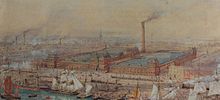19th century




- 1801 - Population of village of Barrow stood at 1,958 during 1801 UK Census
- 1804 - Walney Lighthouse is completed
- 1839 - Henry Schneider arrives to exploit local iron ore
- 1846
- Furness Railway is opened
- Roa Island causeway is completed
- 1847 - Population: 325. [1]
- 1850 - Expansive haematite deposits are discovered in the area
- 1852 - Jane Roper is the first ship to be built in Barrow
- 1858 - St. Mary of Furness Roman Catholic Church is built
- 1859 - Schneider Hannay & Co is founded. [1]
- 1860 - Barrow Co-operative Society is established
- 1861 - St. George's Church is built
- 1863 - Construction begins on Barrow's dock system
- 1865
- A magnitude 3.0 earthquake causes extensive damage to the Rampside area
- Schneider Hannay & Co becomes the Barrow Hematite Steel Company. [1]
- 1867
- Barrow is granted municipal borough status
- Sir James Ramsden becomes first mayor of Barrow
- Devonshire Dock opens. [1]
- Cases' Brewery opens
- 1869 - St. James' Church is built
- 1870 - Barrow Jute Works are completed
- 1871
- The Barrow Shipbuilding Company is established
- Barrow Corn Mills are built
- 1872 - Furness Golf Club is founded
- 1873 - Duke of Devonshire is the first steamship to be built in Barrow
- 1875
- Barrow Football Club, the forerunner of Barrow Raiders is established
- Devonshire Buildings are built
- 1876 - Barrow's steelworks become the world's largest
- 1877 - St. James' Church installs a ring of 8 bells - first rung on St James' day (25th July)
- 1879 - Ramsden Dock completed. [1]
- 1881
- The autonomous Barrow-in-Furness Borough Police force is established
- SS City of Rome is launched, briefly the world's largest liner
- 1882 - Barrow Central railway station is opened
- 1884 - Michaelson Road Bridge is opened
- 1885
- The Barrow and Furness parliament constituency is established
- Barrow-in-Furness Tramways Company commences operation.
- 1886 - Ottoman submarine Abdül Hamid is launched in Barrow and becomes the first submarine to fire a live torpedo underwater
- 1887
- Barrow Town Hall is opened by Spencer Cavendish, 8th Duke of Devonshire
- North Lonsdale Hospital is opened
- 1888 - Town becomes a county borough. [1]
- 1889 - Co-operative Building built.
- 1891 - Population: 51,712. [1]
- 1896 - Death of Sir James Ramsden mechanical engineer, industrialist, and first mayor of Barrow. [1]
- 1897 - The Barrow Shipbuilding Company becomes Vickers Shipbuilding and Engineering after being purchased by Vickers Limited
- 1898 - The North-Western Daily Mail first begins publishing
- 1899 - Barrow-in-Furness power station commissioned.





